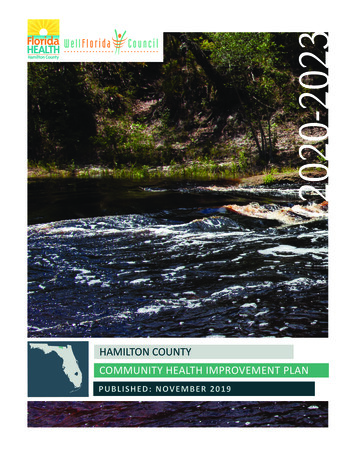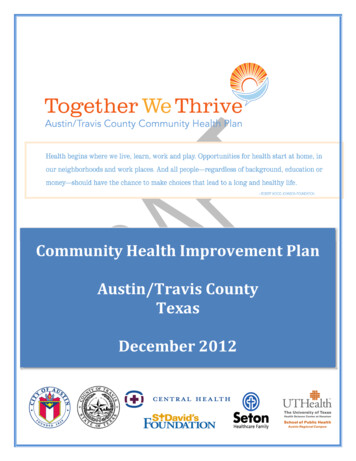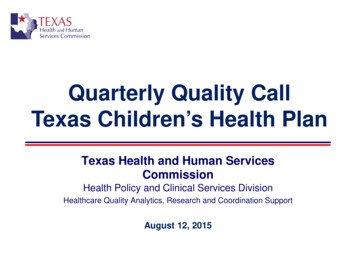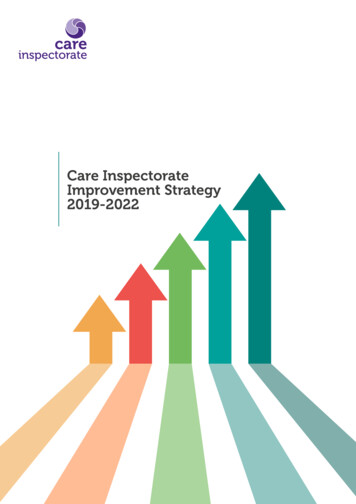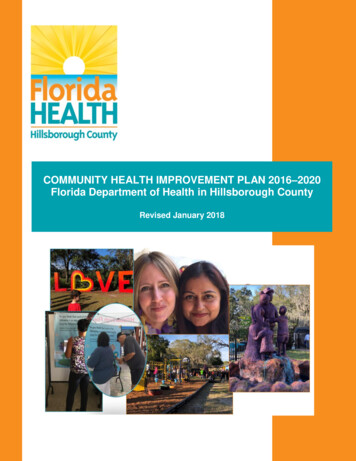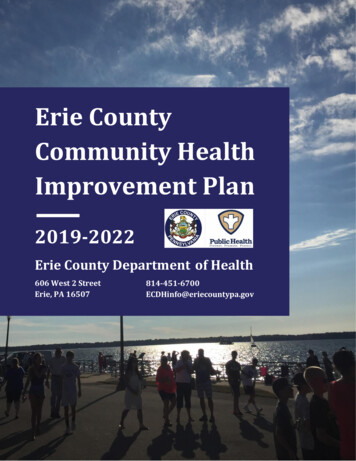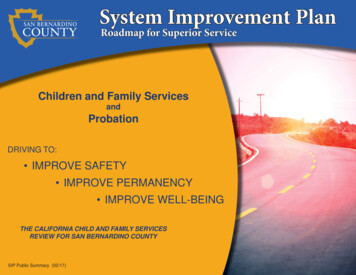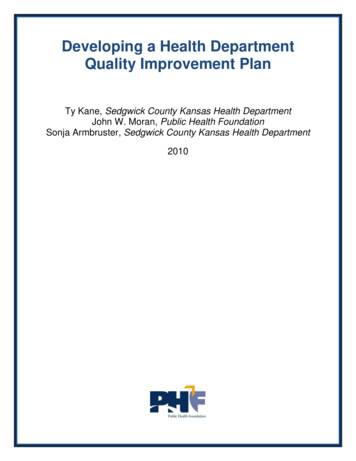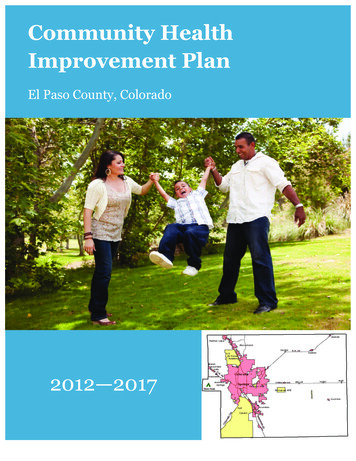
Transcription
Community HealthImprovement PlanEl Paso County, Colorado2012—2017
Table of ContentsAcknowledgements2Executive Summary4Community Description5Public Health11Community Health ImprovementPlanning Process13CHIP: Improving Healthy Eating andActive Living in El Paso County18Other Important Public Health Issues27Resources42Glossary of Terms44Last update: 10/9/131
AcknowledgementsEl Paso County Public Health (EPCPH) gratefully acknowledges the following citizensand agencies who participated in the community health improvement planning processvia the Healthy Community Collaborative (HCC).Academy School District 20Alliance for Drug Endangered ChildrenAmerican Cancer SocietyAmerican Medical ResponseAspenPointeCare and Share Food Bank for SouthernColoradoCedar Springs Behavioral HealthCentro de la FamiliaCity of Colorado SpringsCity of Colorado Springs Parks,Recreation & Cultural ServicesCity of FountainCity of Manitou SpringsColorado Business Group on HealthColorado Springs Chamber ofCommerceColorado Springs Fire DepartmentColorado Springs Health PartnersColorado Springs Regional BusinessAllianceColorado Springs School District 11Community Health PartnershipCommunity Partnership for ChildDevelopmentEl Paso CountyEl Paso County Community ServicesEl Paso County Medical SocietyEl Paso County Public HealthFort Carson Wellness ServicesFountain Valley Community Activityand NutritionGolden Lotus FoundationHarrison School District 2HeartSmartKidsHunger Free ColoradoKaiser PermanenteKing Soopers/City MarketLatino American Health NetworkLiveWell Colorado SpringsManitou Springs School District 14MedicalVoyceMemorial Health SystemNAACPOpen Bible Medical ClinicOwn Your Own HealthPartners for Healthy ChoicesPeak Vista Community Health CentersPenrose-St. Francis Health ServicesPfizer, Inc.Phil Long DealershipsPikes Peak Area Council of GovernmentsPikes Peak Region Healthier SchoolsRocky Mountain Health Care ServicesSt. Francis Mission OutreachSET Family Medical ClinicSuicide Prevention PartnershipTeller County Public HealthTrails and Open Space CoalitionUCCS Beth-el College of Nursing andHealth SciencesUrban PeakUS FoodswellCentersYMCA of the Pikes Peak RegionEPCPH also extends thanks to the Office of Planning and Partnerships at the ColoradoDepartment of Public Health and Environment for their expertise and technicalassistance during this process.Last update: 10/9/132
El Paso County Board of HealthEPCPH staff and the community appreciate the support of El Paso County Board ofHealth in our work toward a healthier community.C.J. Moore, PresidentSharon Brown, Vice-PresidentVictoria BroermanDr. Robert BuxSallie ClarkHelen CollinsKari KilroyAmy LathenDr. James TerbushWriters/Editors, formatters, and content expertsThank you to the EPCPH staff members who assisted in the creation of this documentAmy AndersonDanielle OllerLarry SchaadKathy RiceEpidemiologistOffice of CommunicationOffice of Planning, Partnerships, and AccreditationOffice of Planning, Partnerships, and AccreditationBernadette Albanese, M.D., M.P.H., former EPCPH Medical Director, was instrumentalin the creation of the EPCPH Community Health Assessment and in theimplementation of Colorado’s Health Assessment and Planning System (CHAPS)process to create the Community Health Improvement Plan for El Paso County,Colorado. Our thanks to Dr. Albanese for her invaluable contribution.Thank you, Kelley Vivian, former EPCPH Development and Sustainability Director, foryour dedication to the CHAPS process, your contribution to the writing of the CHIPdocument, and your facilitation of the work of the HCC.A special thanks to all EPCPH staff. Your commitment to the community will continueto advance the work of the HCC.The CHIP is a “living” document that will be revised and enhanced as the CHIPwork continues. This document was created by, and will be the responsibility of,EPCPH. The CHIP will be posted on the EPCPH websitehttp://www.elpasocountyhealth.org/ and will continue to be updated as changesare made. If you have any comments or questions, or want to know how you can beinvolved in this effort, please contact us through the EPCPH website.Last update: 10/9/133
Executive SummaryOn behalf of El Paso County Public Health (EPCPH), I would like to thank everyone inthe community who has assisted in the creation of the Community Health ImprovementPlan (CHIP). Without this support, the CHIP would not be possible. We are all part ofthe “Public Health System” working together to assure the community receives theessential public health services.The CHIP is a long-term, systematic effort to address public health problems on thebasis of the results of the community health assessment and the community healthimprovement process. This plan is used in collaboration with community partners to setpriorities and coordinate resources. A CHIP is critical for developing policies anddefining actions to target efforts that promote health. The CHIP defines the vision forthe health of the community through a collaborative process.To begin the process of developing the CHIP, in 2011 the Healthy CommunityCollaborative (HCC) was formed to create an action plan to improve the health of peopleof El Paso County. HCC is a stakeholder group of community partners which consists ofrepresentatives from schools, hospitals, health systems, non-profit organizations, cityand county government agencies, public health, medical providers, business, andinterested citizens. EPCPH is proud to be a member of HCC and to be a part of the CHIPeffort.HCC has chosen obesity prevention as its focus, targeting community efforts andresources on evidence-based solutions to increase healthy eating and active living.HCC’s goal is to stop the upward trend of overweight and obesity in El Paso Countywithin the next five years and reverse the trend in the coming decade.Although the CHIP is a local effort, we have an ongoing collaborative relationship withCDPHE and other health agencies in Colorado, and the Centers for Disease Control(CDC) and other organizations throughout the country to share expertise andexperiences to enhance our CHIP. Awareness of State priorities and national PublicHealth Accreditation standards are key to the success of the CHIP. Fundingopportunities, quality outcomes, and shared resources will increase the opportunity forsuccessful, sustainable results in El Paso County.Sincerely,Jill Law, RN, BSN, MHAPublic Health DirectorLast update: 10/9/134
Community Description: El Paso County, ColoradoEl Paso County is located in the south central region of Colorado. As of July 2010, the countyhad an estimated 627,096 residents and the population is projected to reach nearly 1 millionover the next three decades (Figure 1). 1 El Paso County is a mix of urban, suburban, and ruralcommunities with about two-thirds (419,353) of the population residing within the city ofColorado Springs. The variation in population density throughout the county is demonstratedin Figure 2, which indicates the number of people per square mile. 2El Paso County’s population is comprised of 50.2 percent females. The median age is 34.1years, with 26.1 percent of the population under the age of 18 years and 10.0 percent over theage of 65 years (Table 1).1,3 The racial and ethnic breakdown in the county shows thepopulation to be predominantly non-Hispanic white (73.9 percent), followed by 15.0 percentHispanic of any race (Figure 3); non-Hispanic black and other non-Hispanic races comprise6.3 percent and 4.8 percent of the total population, respectively.1 Vital statistics data showedthat during 2010, there were 9,187 live births and 3,530 deaths in El Paso County. 4El Paso County has a large military presence, including four military installations – FortCarson Army Base, Peterson Air Force Base, Schriever Air Force Base, and the United StatesAir Force Academy. A 2011 report from the Greater Colorado Springs Chamber of Commerceestimates that these four installations employ nearly 40,500 military personnel andapproximately 21,000 civilian/contract personnel. 5 Three-quarters of military personnel areestimated to live in communities outside the military bases. El Paso County is home to 58percent of Colorado’s military retiree population, according to this report.The median household income in El Paso County was 51,548 in 2010 (Figure 4), with 19.1percent of children younger than 18 years and 10.4 percent of families living below the CensusBureau’s 2010 poverty threshold. 6 Families living in poverty are more concentrated in southColorado Springs, and south-central and eastern El Paso County (Figure 5). An estimated 8.9percent of households in El Paso County received Supplemental Nutrition Assistance Programbenefits (SNAP, formerly known as food stamps) in 2010; among households receiving SNAP,56.2 percent were below the poverty threshold and 60.3 percent included children youngerthan 18 years of age. 7 According to the Colorado Department of Labor and Employment, theaverage unemployment rate in El Paso County during 2011 was 9.5 percent. 8In 2010, 22.0 percent of El Paso County residents ages 25 years and older held a high schooldiploma or equivalent as their highest degree, and just over one-third held a bachelor’s degreeor higher (Figure 6). 9 The on-time graduation rate, defined as the number of students whocompleted high school within four years, for the class of 2010 was 78.4 percent. 10 During thesame academic year, 2.1 percent of seventh to twelfth grade students dropped out of school inEl Paso County.Last update: 10/9/135
An estimated 11.0 percent of people ages 5 years and older in El Paso County spoke a languageother than English at home in 2010, with more than half (58.3 percent) being Spanishspeaking.9 Of those speaking a language other than English at home, 36.2 percent wereconsidered linguistically isolated (defined as speaking English “less than very well”).Figure 1. Population estimates and projected forecast, El Paso County 2000 ,802300,000200,000100,0000YearLast update: 10/9/136
Figure 2. Population density (people/square mile), by census tract, El PasoCounty 2010Table 1. Age distribution of El Paso County population, 2010AgeLast update: 10/9/13NumberPercent of populationUnder 18 years163,42526.1%18 to 24 years68,64810.9%25 to 44 years170,54727.2%45 to 64 years161,65625.8%65 years and older62,82010.0%7
Figure 3. Hispanic population, percent by census tract, El Paso County 2010Figure 4. Annual household income, El Paso County 2010 75,000 and higher32.9% 50,000- 74,99919.4% 25,000- 49,99924.6%Less than 25,00023.2%05101520253035Percent of householdsLast update: 10/9/138
Figure 5. Percent of families below poverty threshold, by census tract, El PasoCounty 2006 to 2010Last update: 10/9/139
Figure 6. Educational attainment among adults ages 25 years and older, El PasoCounty 2010Graduate or professional degree13.0%Bachelor's degree21.1%Associate's degree10.0%Some college26.8%High school graduate22.0%Less than high school7.2%051015202530Percent of adults ages 25 years and older1Colorado State Demography Office [Internet]. Population Data. Available from: 3300013.2U.S. Census Bureau [Internet]. 2010 Census. Population, Housing Units, Area, and Density: 2010 – County – Census Tract(Table GCT-PH1). Available from: http://factfinder2.census.gov/main.html.3U.S. Census Bureau [Internet]. 2010 Census. Profile of General Population and Housing Characteristics (Table DP-1).Available from: http://factfinder2.census.gov/main.html.4Colorado Department of Public Health and Environment [Internet]. 2010 State and County Birth and Death SummaryTables. Available from: www.chd.dphe.state.co.us/topics.aspx?q Maternal Child Health Data.5Greater Colorado Springs Chamber of Commerce [Internet]. Colorado’s Valuable National Assets: A brief look atColorado’s military [April 2011]. Available from: www.coloradospringschamber.org/military/.6U.S. Census Bureau [Internet]. 2006-2010 American Community Surveys. Selected Economic Characteristics in the UnitedStates (Table DP03). Available from: http://factfinder2.census.gov/main.html.7U.S. Census Bureau [Internet]. 2010 American Community Survey. Food Stamps/SNAP (Table S2201). Available rado Department of Labor and Employment [Internet]. 2011 Local Area Unemployment Statistics. Available default.asp.9U.S. Census Bureau [Internet]. 2010 ACS. Selected Social Characteristics in the United States (Table DP02). Available orado Department of Education [Internet]. 2009-2010 Colorado Education Statistics. Available from:www.cde.state.co.us/index stats.htm.Last update: 10/9/1310
Public HealthWhat is Public Health?Public health is defined as “the science and practice of protecting and improving thehealth of a community, as by preventative medicine, health education, control ofcommunicable diseases, application of sanitary measures, and monitoring ofenvironmental hazards.” i The role of public health is to protect and improve the healthof an entire population rather than individuals. Public health strives to limit healthdisparities, working toward health care equity for the population it serves.Public health systems are broader than simply the local or state public health agency. Infact, the public health system includes all public, private, and voluntary entities thatcontribute to the delivery of essential public health services within a jurisdiction ii(Figure 1). In Colorado, public health core services are defined by state legislation andthe local public health agency is responsible for assuring the provision of these coreservices within their jurisdiction, typically within county boundaries. Examples of corepublic health services include assuring clean air and water, safe food, health educationto prevent chronic disease and injury, and investigating infectious disease outbreaks,among other priorities.In addition to assuring core public health services, local public health agencies arerequired by the Public Health Act, Colorado Senate Bill 194, to complete a communityhealth assessment (CHA) and a community health improvement plan (CHIP). The CHAand CHIP must be conducted with a multi-agency community group, use current localhealth indicator data, and align with the statewide public health improvement plan. TheNational Public Health Accreditation Board (PHAB) requires the CHA, CHIP, and anagency Strategic Plan for the accreditation of local public health agencies. Accreditationis new to public health, but will act similarly to hospital and university accreditation, inthat accredited agencies will be recognized as those that provide quality services, arefinancially accountable, use evidence-based practices, and work with broad communitypartnerships. El Paso County Public Health (EPCPH) earned national accreditationstatus by the Public Health Accreditation Board on August 20, 2013.Public Health’s “Winnable Battles”Both the Centers for Disease Control and Prevention (CDC) and the ColoradoDepartment of Public Health and Environment (CDPHE) released a set of “WinnableBattles” for public health where significant progress can be made in the comingdecade. Winnable Battles are key public health and environmental issues wheresubstantial progress can be made to improve population health. In Colorado, CDPHEselected ten Winnable Battles that impact a high percentage of the population; involvesignificant health disparities; impose a large economic burden or risk on quality oflife or the environment; and are consistent with state and federally-mandatedprograms designed to improve and protect the environment and public health (Figure2). Colorado’s Winnable Battles also were selected because evidence-based strategieswith proven impact exist for these population health areas and in many localitiesthere is community-level readiness and support for change.Last update: 10/9/1311
Figure 1: The Public Health SystemCivic rsDrugTreatmentPublic Faith InstitutionsFireTribal rom: CDC,CorrectionsOfficialsNPHPSP Overview Presentation, igure 2: Colorado’s Ten Winnable BattlesClean AirClean WaterInjury PreventionInfectious Disease PreventionMental Health and Substance AbuseLast update: 10/9/13ObesityOral HealthSafe FoodTobaccoUnintended Pregnancy12
Community Health Improvement Planning ProcessIn response to the Public Health Act, also known as Senate Bill 194, enacted by the statelegislature in 2008, CDPHE’s Office of Planning and Partnership (OPP) developedColorado’s Health Assessment and Planning System (CHAPS) process to provide astandard mechanism for assisting local public health agencies in meeting assessmentand planning requirements. Senate Bill 194 requires state and local public healthagencies to create community health improvement plans (CHIP) for their jurisdictions.The CHIP must be completed every five years and be based upon (Figure 3): A community health assessment including local health indicator data;A capacity assessment of community resources available to work on communityhealth issues; andA prioritization process in which a broad stakeholder group are engaged indetermining community priorities.Figure 3: The CHAPS ProcessCommunity Health Improvement PlanCapacityAssessmentPrioritizationSystematic ResourceAssessmentSystematic Scoring ofNeeds CapacitySupplementalData AnalysisPartner InterestInclude EvidenceBased strategiesOrganizationalExpertisePolitical & mentCHIPEPCPH was selected by CDPHE to work closely with OPP as a pilot site for the CHAPSprocess. As a result, EPCPH was able to effectively implement CHAPS in El Paso Countybased on the following activities and timeline: April 2010: EPCPH convenes 57 attendees, including 24 partners representing21 various agencies as well as 33 internal staff members to assess the Local PublicHealth System through the use of the National Public Health PerformanceStandards Program (NPHPSP) Local Public Health System (LPHS) Assessment.The LPHS indicated areas for improvement within the local public health systemLast update: 10/9/1313
and within EPCPH. One area for improvement noted was to complete a CHA andCHIP and foster better community engagement. EPCPH used this information asit began the CHA and CHIP processes. June 2011: EPCPH convenes a stakeholder group of roughly 49 communityagencies and over 80 members called the Healthy Community Collaborative(HCC). The HCC agrees to a scope of work that includes review of local healthindicator data for the CHA, designing and participating in: capacity assessments,key informant interviews, prioritizing community health needs, and creating andimplementing a CHIP.The HCC consists of representatives from schools, hospitals and health systems,non-profit organizations, city and county government agencies, public health,medical providers, and interested citizens. The vision of the HCC is to create andsustain healthier communities by inspiring health and wellness. The HCC willachieve this vision by building an integrated system of community partnershipswhich puts practices into place that provide people the opportunity to have betterhealth outcomes. July-August 2011: EPCPH provides local health indicator data to the HCC.Data is presented within the content areas of Colorado’s Ten Winnable Battles.Data was stratified by sex, age, income, education, and race/ethnicity todetermine where health inequities exist.Key informant interviews of selected HCC members were conducted by EPCPHstaff using a standardized questionnaire focused on population health issues.Twenty-eight key informant interviews were conducted. September-October 2011: EPCPH develops a capacity assessment survey tomeasure potentially available resources within the community to address thefollowing population health topics selected by HCC as the most important localissues:ooooooDiet and Physical ActivityTobacco UseMental Health and Substance AbuseUnsafe Sexual Practices and Teen PregnancyMotor Vehicle InjuryOral HealthFifteen assessments completed by HCC members are returned for evaluation.EPCPH provides information to the HCC on evidence-based interventions (EBIs)for the selected population health topics. Sources for EBIs include Task Force onCommunity Preventive Services (The Community Guide), Cancer ControlPLANET, Substance Abuse and Mental Health Services AdministrationLast update: 10/9/1314
(SAMHSA), National Registry of Evidence-Based Programs and Practices(NREPP), and Healthy People 2020.HCC meets to discuss the burden of disease in the community for each topic areaby reviewing health indicator data and national costs of poor health outcomesrelated to these diseases or conditions. The HCC ranks the relative burden foreach topic area based on their determination of the effect of each health issue onthe community as a whole. The HCC determines that the most important healthissues facing El Paso County are (in order) diet and physical activity, mentalhealth and substance abuse, tobacco, unsafe sexual practices and teen pregnancy,motor vehicle injury, and oral health. November 2011: The HCC meets to determine priorities for the CHIP. TheHCC reviews health indicator data, the burden ranking outcomes, the results ofthe capacity assessment, potential EBIs, and the community’s interest in workingin each topic area. The HCC discusses these items and then ranks each healthfocus area to determine community priorities. Diet and physical activity andmental health are the top two ranked priorities. The HCC determines that it canbe most impactful by focusing on one topic area and chooses to focus onimproving healthy eating and active living in El Paso County. December 2011: The preliminary CHA is presented to elected officials,community groups, and posted on EPCPH’s website for community feedback andcomment. January 2012: EPCPH and the HCC release a second capacity assessment forhealthy eating and active living programs already in existence in El Paso County.The survey was sent to HCC members and other community agencies identifiedby the HCC. Thirty agencies with fifty initiatives responded to the survey. Basedon survey results, an inventory of community initiatives that address healthyeating and active living is created and gaps in services are identified. Thisinformation is placed in a sector-based matrix (e.g., child care, school, workplace, community, media, food systems, etc.) along with information about EBIsfor each sector to allow the HCC to determine how to work to improve healthyeating and active living. February 2012: The HCC divides into a Steering Committee and sector-basedtask forces to create the CHIP. From here the CHIP document with goals,objectives, and activities will be created by the HCC. The HCC and EPCPH will beresponsible for implementation and evaluation. March 2012: The HCC Steering Committee meets to determine the overarchinggoal for the CHIP. This goal is presented to the HCC and affirmed by themembership. Based on the goal, sector-based task forces were chosen to reviewwhat strategies had the best chance at success for achieving the selected goal andobjectives. Lead agencies were selected, activities outlined, and evaluationmetrics established for short and long term outcomes.Last update: 10/9/1315
Overarching goal for CHIP: HCC will stop the upward trend of overweightand obesity in El Paso County within the next five years and reverse the trend inthe coming decade. April 2012: The HCC meets to form task forces, select leaders, determinecommunication methods, set meeting norms, set meeting schedule, and identifypotential partners for the task forces. May 2012: Task forces receive training on logic models, evidence-basedinterventions, literature reviews, and the social determinant of health models. June/July 2012: Task forces complete literature reviews, review capacityassessments, and use established criteria for determining strategies. August 2012: Task Forces select strategies, complete logic models, and presentlogic models to the HCC membership. September 2012: HCC Steering Committee reviews logic models and givesfeedback to task forces and HCC membership at monthly HCC meeting.Strategies are discussed. Population health and common themes from the taskforce logic models are discussed. There is agreement that further discussion isneeded to determine what strategies the HCC will implement. Further discussionat the October 2012 meeting. October 2012: The HCC meets to view a presentation on Obesity messagingand discuss how we could potentially apply this information tomessaging/branding/taglines for HCC. HCC task forces are asked to meet and tobrainstorm ideas for messaging/branding/taglines, to submit feedback to theHCC Steering Committee, and to discuss at the January 2013 HCC meeting. December 2012: The HCC Steering Committee meets to plan the January 2013HCC meeting. Messaging and logic models will be discussed. January 2013: The HCC meets to review feedback from task forces onmessaging ideas. HCC decides it is too early to proceed with working onmessaging/branding/taglines. HCC Steering Committee asks task forces to meetand review the logic models created and presented to HCC in August 2012 using alist of questions designed by the Steering Committee. The task forces are askedto submit this information to the HCC Steering Committee by March 31, 2013.This information will be reviewed by the HCC Steering Committee and feedbackgiven at the May 15, 2013 HCC meeting.Last update: 10/9/1316
February, 2013: EPCPH submits the most updated version of the CHIP,January 18, 2013, to CDPHE OPP. Colorado Public Health Act (Senate Bill 194)requires that every local public health department create a CHIP every five years.EPCPH is a pilot site for Colorado’s Health Assessment and Planning Process(CHAPS). As part of this pilot, EPCPH is required to submit the CHIP to CDPHEby February 15, 2013. Also required that El Paso County Board of Health reviewthe CHIP. CHIP emailed to EPC BOH on January 18, 2013 for review. April, 2013: Healthy Community Collaborative (HCC) Committee met andevaluated proposed projects. May, 2013: HCC meeting announced the projects moving forward: CoordinatedSchool Health Team and Worksite Wellness Challenge Team. Three additionalteams have also been created: Messaging Team; Evaluation and Evidence-basedResearch Team; and Resource Team. June, 2013: Messaging Team met for the first time. Due to the Black ForestFire, Steering Committee meetings with project teams were delayed. July, 2013: Healthy Community Collaborative (HCC) Steering Committeedrafted work plan template. HCC Messaging team refined brand and taglineconcepts for presentation at the HCC meeting in August. August, 2013: HCC Steering Committee finalized work plan template forpresentation to project teams in September. HCC Messaging team presented andsolicited feedback on brand and tagline concepts. September, 2013: HCC Evaluation and Evidence Based Research team met todevelop a strategy to assist project teams with developing work plans. HCCSteering Committee met with project teams. Work plan template was presentedand HCC Evaluation and Evidence Based Research team supports were explainedto project teams.Last update: 10/9/1317
CHIP: Improving Healthy Eating and ActiveLiving in El Paso CountyThe growing problem of overweight and obesityAlthough Colorado continues to rank as one of the leanest states in terms of weightindicators, it has not escaped the national obesity epidemic. This is true for El PasoCounty as well, where an estimated 37.1 percent of the adult population in El PasoCounty was overweight and 21.2 percent, or 1 in 5 adults, was obese in 2009 to 2010(Figure 1). iiiFor children ages 2 to 14 years in El Paso County, 28.5 percent were of excessive weightbetween 2008 and 2010. iv Figure 1 also shows that almost one in five Colorado highschool students were at an unhealthy weight in 2009 (7.1 percent obese and 11.1 percentoverweight). vDisparities exist for people who are overweight and obese based on income, education,and race (Figure 2). There is a trend, although not statistically significant, for blackadults to have higher prevalence of obesity as compared to white or Hispanic adults.Also, obesity is more common among people in households earning less than 25,000per year and, interestingly, is higher in people who graduated high school or have amore advanced degree.6Figure 1. Percent of population with unhealthy weight, El Paso County andColorado 2008 to 2010Last update: 10/9/1318
The growing trend of overweight and obese children and adults is putting people at riskfor poor health outcomes including hypertension, high cholesterol, and non-gestationaldiabetes. In El Paso County, the number of adults with these conditions has increasedsubstantially in the past decade, paralleling trends in obesity. Between 2003 and 2009,hypertension among adults has risen from 14.7 percent to 19.2 percent, and highcholesterol rose from 25.5 percent to 34.5 percent among those who had theircholesterol levels checked.5 The prevalence of non-gestational diabetes increased from3.8 percent among adults in 2003-2004 to 5.4 percent in 2009-2010, representing a 42percent increase overall. Figure 3 illustrates that people with unhealthy BMI aresubstantially more likely to suffer from hypertension, high cholesterol, and nongestational diabetes. viFigure 2. Percent of adults 18 years
Community Description: El Paso County, Colorado El Paso County is located in the south central region of Colorado. As of 2010, the county July had an estimated 627,096 residents and the population is projected to reach nearly mill1 ion over the next threedecades 1 (Figure 1). El Paso Countyis a mix of urban, suburban, and rural
